Introduction:
Why I Knew Something Had to Change
Growing up in a house where emotional isolation, guilt-tripping, and shouting were the accepted parenting techniques, I developed Not criminals, my parents were merely repeating what they knew. But I started to see the same trends invading me when I started parenting. It alarmed me and I want to break generational parenting patterns.
When I spoke, I wanted my children not to flinch. I wanted children to experience emotional support, safety, and love free from conditions. This is the actual, unvarnished tale of how I began to step-by-step break those generational cycles.
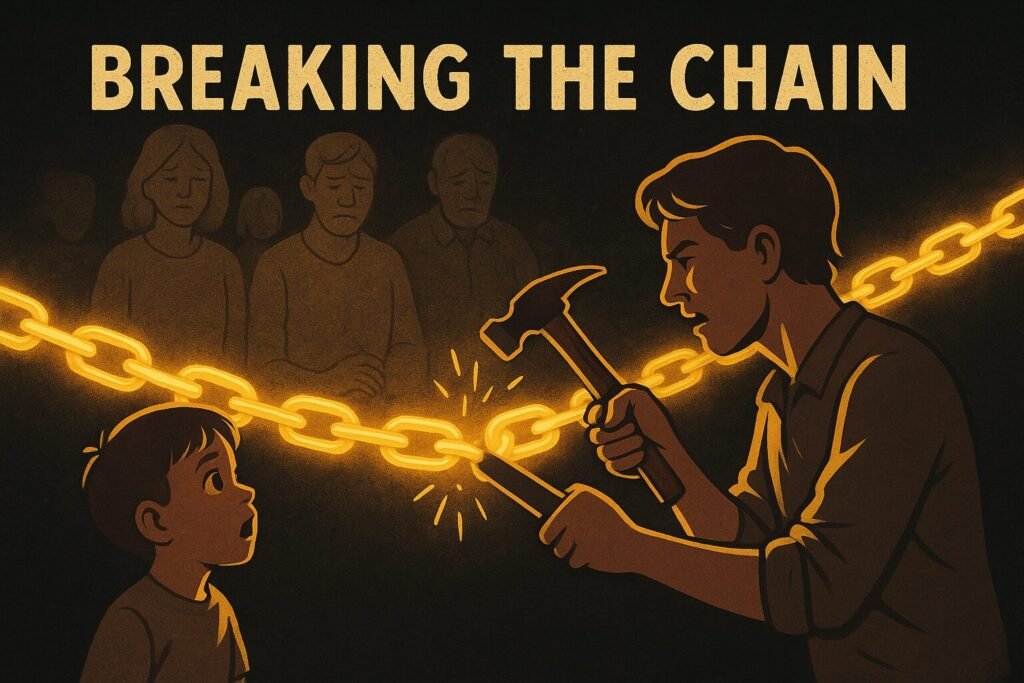
Step 1: Recognize the Patterns in Yourself
The first, most painful step was honesty.
- I yelled when I felt powerless.
- I withdrew when I felt hurt.
- I repeated things I swore I’d never say.
I started keeping a journal of moments I regretted—what I said, how I felt, and what triggered me. Patterns became clear. The child in me was still reacting through my parenting.
💬 Real Story: I once yelled at my daughter for spilling juice. Her silent, tearful look mirrored my childhood. That was my wake-up call.
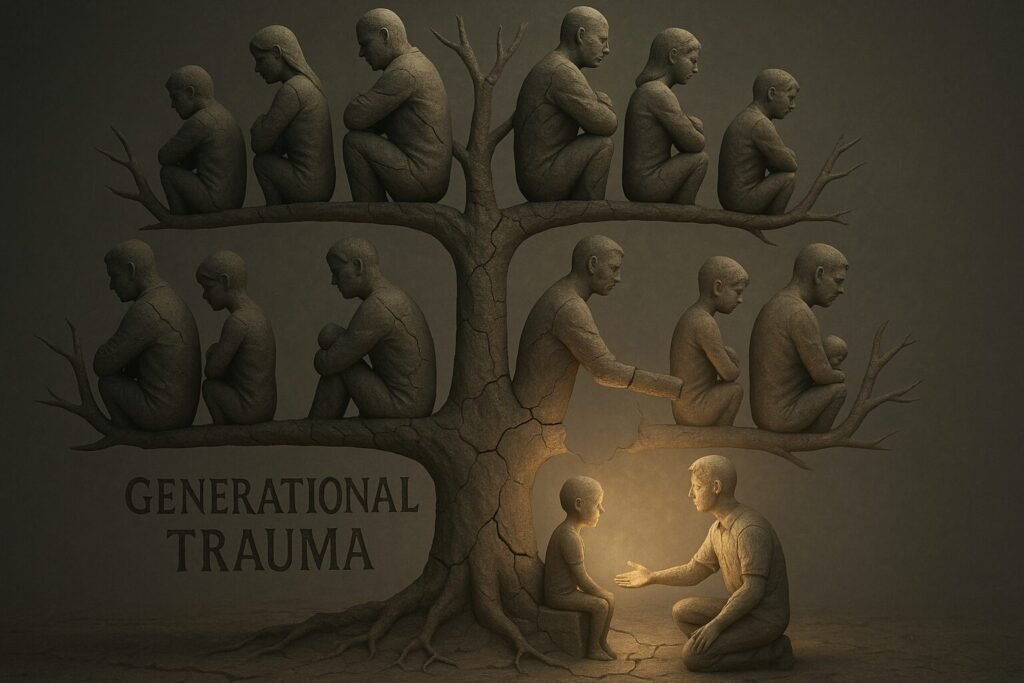
Step 2: Understand Generational Trauma
Generational trauma isn’t always about abuse. Sometimes it’s about emotional suppression, rigid discipline, or unmet needs.
I learned that trauma could be passed through:
- Family beliefs (“Tough love is the only love”).
- Parenting styles (“Children should be seen, not heard”).
- Emotional detachment.
Reading books like It Didn’t Start With You changed how I viewed my parents. They weren’t “bad”; they were unhealed.
Step 3: Reparenting My Inner Child
You can’t pour from an empty cup. I realized I couldn’t parent with empathy if I didn’t first give myself what I never received:
- Comfort.
- Encouragement.
- Emotional validation.
So I represented myself:
- I spoke kindly to myself in moments of stress.
- I allowed myself to cry.
- I forgave myself for not knowing better sooner.
Checklist for Reparenting:
- Daily affirmations.
- Time for self-care.
- Saying “I’m proud of you” to yourself.
- Talking to your inner child.
Step 4: Respond, Don’t React
Parenting isn’t about control; it’s about connection. I had to unlearn yelling and learn emotional regulation.
Instead of yelling:
- I paused.
- I asked, “What’s really going on here?”
- I taught through calm, not fear.
What Helped:
- Deep breathing.
- Saying, “Let me try that again.”
- Reframing outbursts as signals, not misbehavior.
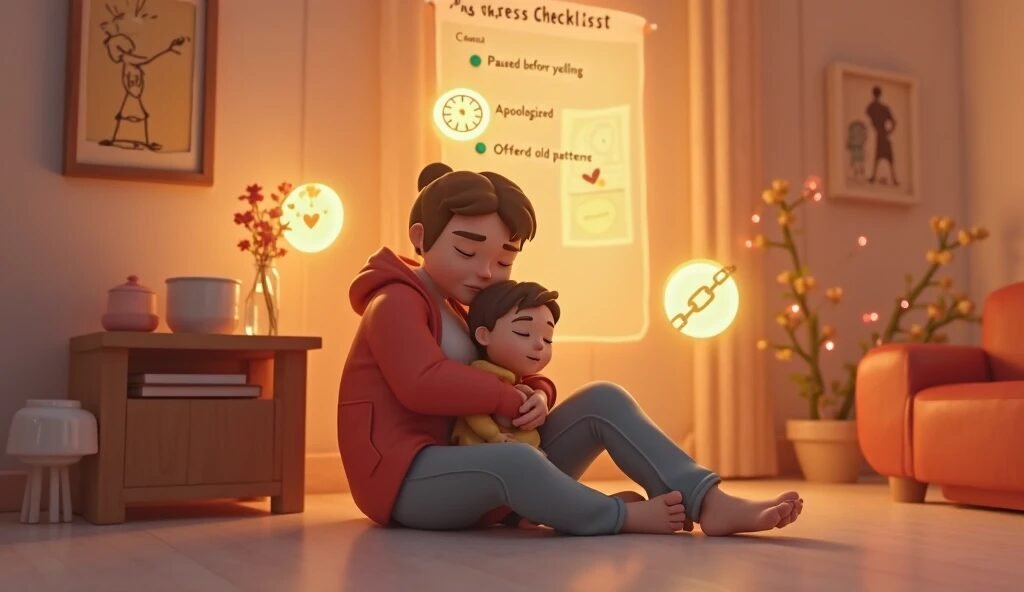
Step 5: Build New Parenting Habits
I didn’t just stop yelling—I had to build new, loving habits:
- Nightly reflections: “How did I parent today?”
- Therapy: To process my own wounds.
- Books & podcasts: My toolkit grew over time.
Recommended Tools:
- The Whole-Brain Child – for understanding your child’s mind.
- Peaceful Parents, Happy Kids – to shift from punishment to connection.
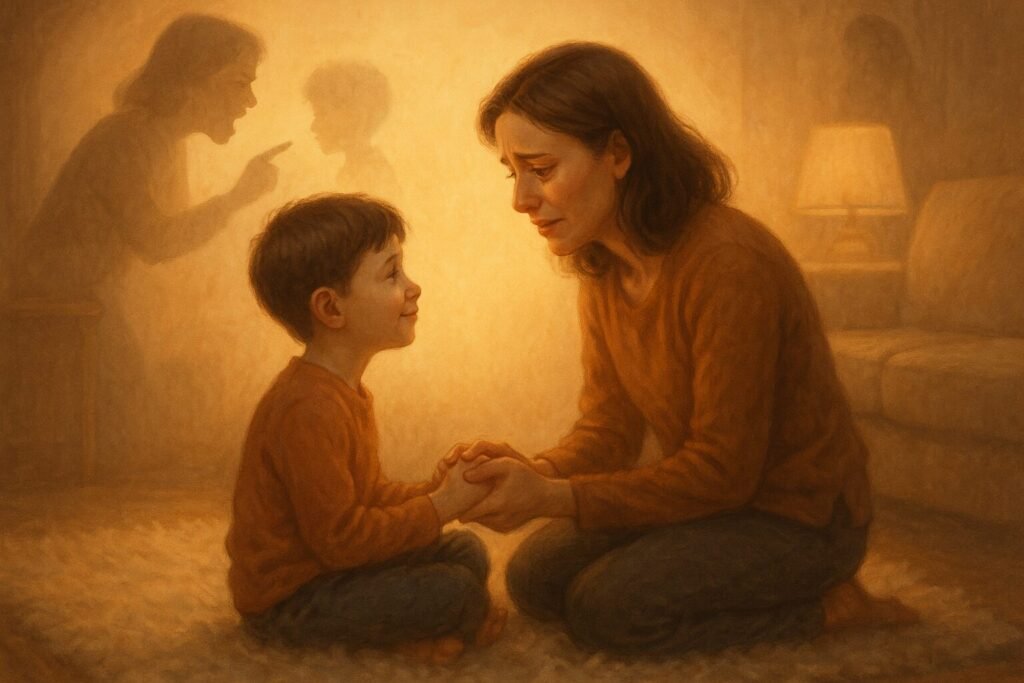
Step 6: Have Hard Conversations with Your Kids
Children understand more than we think. I started narrating my own growth:
“I’m sorry for yelling. I’m working on being a better mom.”
This didn’t make me weak. It built trust. My kids saw that mistakes are okay and that growth is possible.
My son once said, “I know you’re trying, Mama.” That moment broke and healed me at once.
Step 7: Let Go of Perfectionism
Healing is messy. You’ll mess up—and that’s okay.
I stopped striving to be a “perfect parent” and started aiming for a present one. One who apologizes, learns, and tries again.
Pain Point: I thought if I didn’t get it right 100% of the time, I was failing. Truth? Every attempt to do better counts.
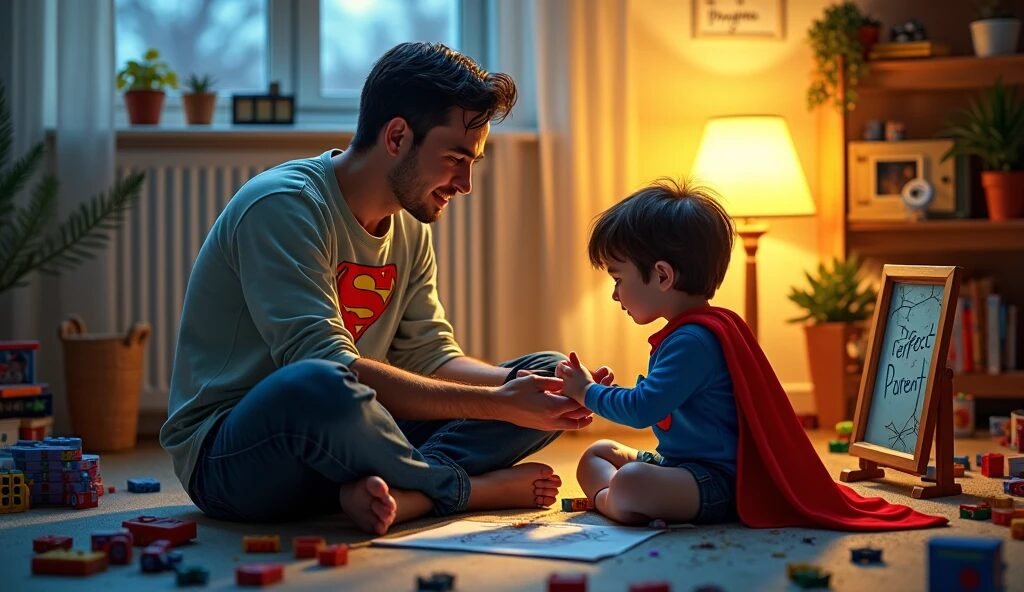
Step 8: Build a Support System
You can’t do this alone. I found strength in:
- Online parenting forums like r/conscious parenting.
- Friends on the same journey.
- Therapists who got it.
Surround yourself with people who say, “Me too,” not “Just spank them.”

Step 9: Celebrate the Small Wins
You won’t see massive change overnight. But tiny victories are everything.
- The day I paused before yelling.
- The first time I apologized instead of defended.
- When my child came to me with their feelings—without fear.
Track Your Wins:
- Did I react or respond?
- Did I offer empathy?
- Did I break an old pattern?
Step 10: Teach What You’re Learning
Your healing becomes your child’s foundation.
I now:
- Talk about feelings openly.
- Model healthy conflict.
- Teach boundaries and empathy.
If my kids grow up and say, “I felt safe with my parents,” then I’ve done enough.

Step 11: Understanding Your Parenting Triggers
Every time I reacted in anger, it wasn’t just about the spilled juice or the noise—it was something deeper. I started keeping a “trigger journal.”
I’d write down:
- What happened
- What I felt
- What it reminded me of from my own childhood
This helped me understand: I wasn’t angry at my child—I was reliving moments where I felt powerless as a kid.
Checklist: Identifying Your Triggers
- Do I feel out of control?
- Does this remind me of how I was treated?
- Am I reacting to my child—or to my past?
Healing begins where awareness lives.
Step 12: Breaking the Silence Around Mental Health
In my family, talking about feelings or therapy was taboo. But I knew I needed help. I reached out to a therapist and started doing the deep work.
That one choice saved my parenting—and probably my life.
Now, I speak openly about therapy with my kids. I say, “We all need support sometimes.” It breaks the shame. It builds emotional safety.
Real Story:
A friend told me, “When you told your child you were going to therapy, mine heard it too. Now she wants to talk to someone. You’re changing more than one life.”
Step 13: Dealing with Cultural and Family Pushback
One of the hardest parts? My own family didn’t understand why I was parenting differently.
“You’re too soft,” they said. “You’re letting them win.”
But I had to stay rooted in my values, not my fear of judgment.
Tips to Handle Pushback:
- Share your “why,” not just your “what.”
- Set clear boundaries with love.
- Find a like-minded community to lean on.
Yes, it’s lonely at first—but you’re planting new seeds.
Step 14: Teaching Emotional Intelligence at Home
I realized I was never taught how to name emotions. So, I started with the basics—with my kids and with myself.
We use:
- Emotion cards during playtime
- The phrase: “Can you show me with your face how you feel?”
- Daily check-ins: “What was the best and hardest part of your day?”
Emotional literacy is the legacy I want to leave.
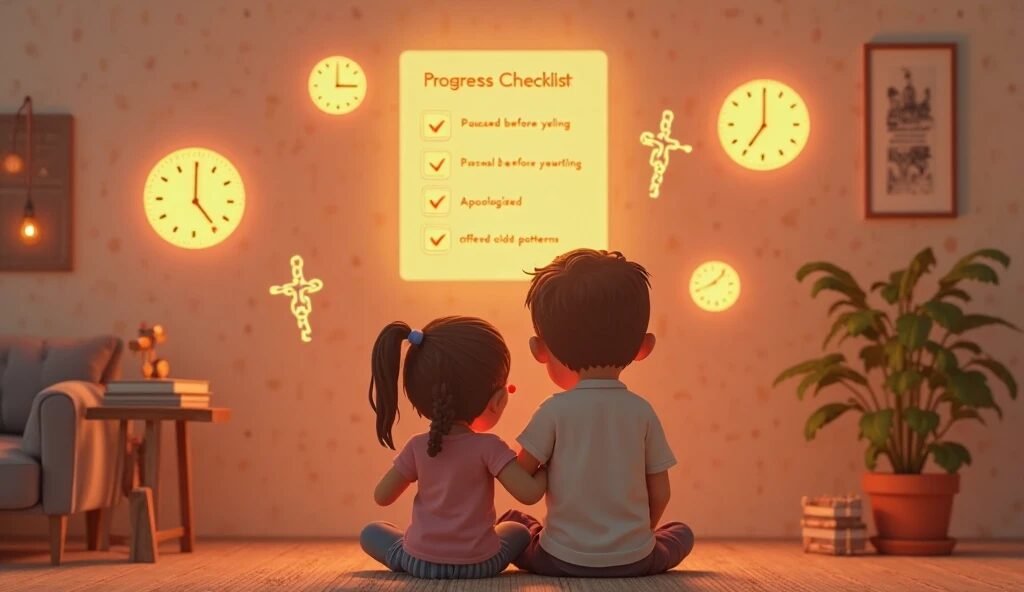
Step 15: Creating a Safe Home Environment (Physically and Emotionally)
Safety isn’t just about locked doors—it’s about feeling safe to be yourself.
Here’s what changed in our home:
- No more threats like “If you don’t listen, I’ll leave you.”
- Soft spaces for meltdowns, not punishment corners
- Words like “I’m here,” “I see you,” “We’ll figure it out together”
These tiny changes helped my kids relax—and helped me feel more grounded too.
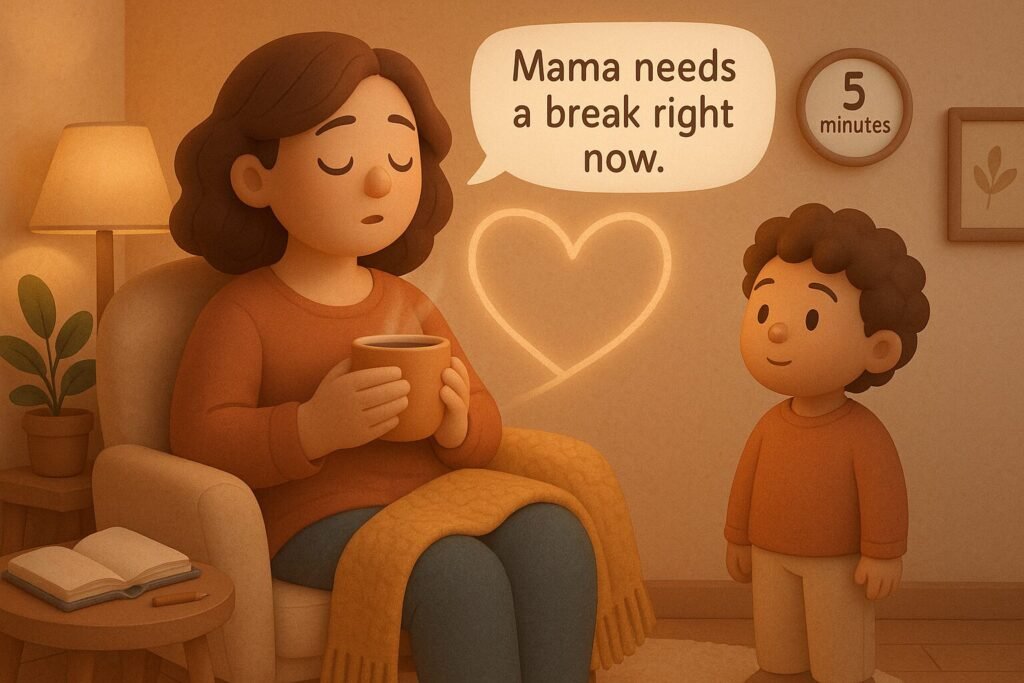
Step 16: Modeling Self-Care and Boundaries
Our kids learn from what we model. So I started saying things like:
- “Mama needs a break right now.”
- “I’m feeling frustrated. I’ll take 5 minutes and come back.”
I used to think self-care was selfish. Now I know it’s survival.
Boundary Script:
“I love you, and I need to take care of myself too. That helps me take better care of you.”
Step 17: Healing the Inner Child Through Play
There was a moment when I danced in the rain with my kids—and cried. Why? Because I never got to do that as a child.
Play heals. So I started coloring again. Building forts. Making silly voices. Laughing loudly.
The more I connected with joy, the more my children did too. We healed together.
Pain Points to Address:
- Feeling like you’re becoming the parent you swore you’d never be
- Fear that you’re “ruining” your child
- Lack of support from family or spouse
- Emotional exhaustion and self-doubt
- Not knowing how to do better, even though you want to

Breaking the Silence with My Parents
Eventually, I talked to my own parents about how their parenting affected me.
It wasn’t easy.
But I shared with love, not blame. And it opened a new chapter of mutual understanding.
Real Quote: “I did the best I could,” my mother said. And I finally believed her.
Cultural Expectations vs. Gentle Parenting
In my culture, obedience is often praised more than emotional intelligence.
Pain Point: Family said I was “too soft.”
But I knew I wasn’t raising robots—I was raising future adults. I stuck to my path. Now, those same relatives see the confidence in my children.
Final Thoughts: You Can Break the Cycle Too
If you’re here, reading this, it means you want something better—for your kids and for yourself. And that’s where change begins.
You don’t need to be perfect. You just need to be present, honest, and willing. One small choice at a time creates a new legacy.
Your healing is their inheritance.
Final Checklist for Healing & Growth
- Identify emotional triggers
- Journal parenting reactions
- Practice reparenting daily
- Create a calm-down ritual
- Seek therapy or coaching
- Model healthy communication
- Build a support system
- Be vulnerable with your kids
- Celebrate small wins
- Keep learning
“If this story spoke to you, know you’re not alone. Share your story in the comments or pass this article to someone who needs it. Together, we rise—and heal
Final Thoughts: You Can Break the Cycle Too
If you’re here, reading this, it means you want something better—for your kids and for yourself. And that’s where change begins.
You don’t need to be perfect. You just need to be present, honest, and willing. One small choice at a time creates a new legacy.
Your healing is their inheritance.
FAQ: Breaking Generational Parenting Patterns
Q1: Is it too late to change if my kids are already teenagers?
No. Children of all ages benefit from seeing their parents evolve.
Q2: What if my partner doesn’t support this new parenting style?
Start with your own growth. Share your wins. Lead by example.
Q3: How do I stop reacting when I’m triggered?
Practice mindfulness. Take space when needed. Therapy helps identify deep-rooted triggers.
Q4: Isn’t gentle parenting just letting kids do whatever they want?
No. Gentle parenting is about connection with firm but kind boundaries.
✅ Final Suggestion:
“If this story spoke to you, know you’re not alone. Share your story in the comments or pass this article to someone who needs it. Together, we rise—and heal

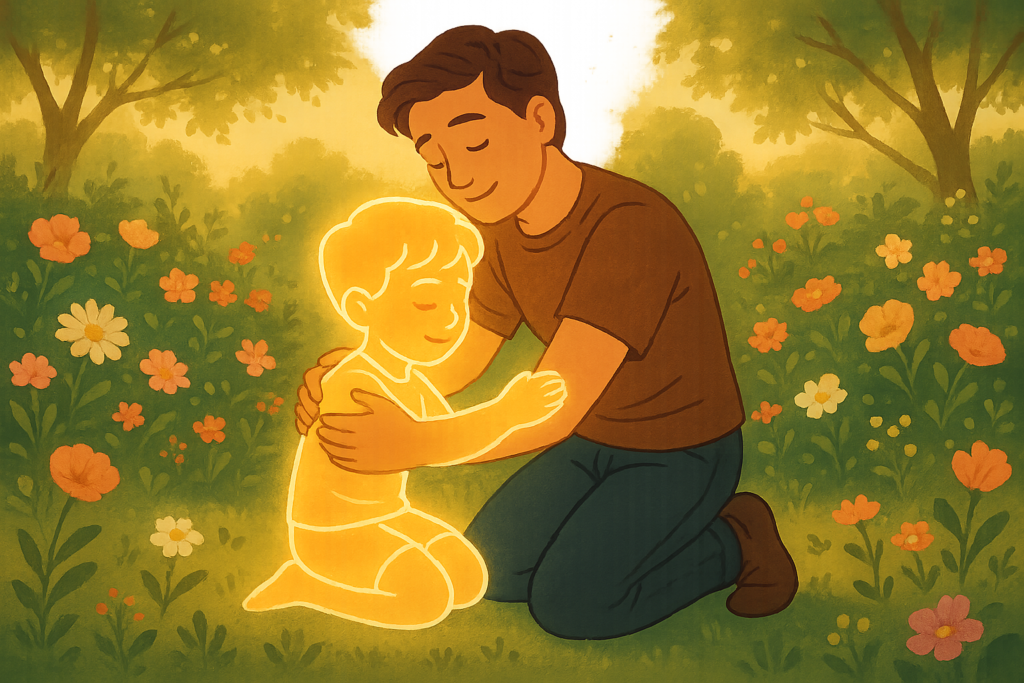
Pingback: Special Needs Stroller 2025 | Real Solutions For Parents